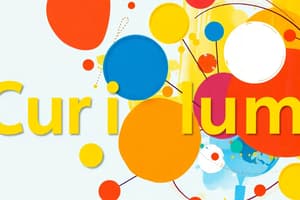Podcast
Questions and Answers
What is a key characteristic of the 'SCOPE' in curriculum design?
What is a key characteristic of the 'SCOPE' in curriculum design?
- It prioritizes the depth of content over its breadth.
- It emphasizes the chronological arrangement of topics.
- It is focused on detailed sequences of lesson plans.
- It includes various domains of learning divided into units. (correct)
Which principle of sequencing involves presenting simpler concepts before more complex ones?
Which principle of sequencing involves presenting simpler concepts before more complex ones?
- Whole to Part Learning
- Chronological Learning
- Simple to Complex (correct)
- Prerequisites Learning
What does the principle of 'Whole to Part Learning' emphasize in curriculum sequencing?
What does the principle of 'Whole to Part Learning' emphasize in curriculum sequencing?
- Detailing foundational knowledge first in all subjects.
- Starting with historical context before detailed study.
- Learning specific details before understanding the overview.
- Introducing general concepts before moving to specific details. (correct)
Which principle dictates that certain knowledge must be learned before advancing to more complex subjects?
Which principle dictates that certain knowledge must be learned before advancing to more complex subjects?
How is the 'SEQUENCE' of a curriculum primarily focused?
How is the 'SEQUENCE' of a curriculum primarily focused?
What is the purpose of vertical repetition in a curriculum?
What is the purpose of vertical repetition in a curriculum?
What term does Gerard Bruner use to describe developing ideas in a spiral fashion?
What term does Gerard Bruner use to describe developing ideas in a spiral fashion?
What is the essence of curriculum integration?
What is the essence of curriculum integration?
What does vertical articulation in a curriculum ensure?
What does vertical articulation in a curriculum ensure?
What could be a consequence of imbalance in curriculum design?
What could be a consequence of imbalance in curriculum design?
What is NOT a goal of vertical alignment in the curriculum?
What is NOT a goal of vertical alignment in the curriculum?
How can horizontal articulation be characterized?
How can horizontal articulation be characterized?
What does an equitable balance in curriculum design involve?
What does an equitable balance in curriculum design involve?
What is one challenge associated with achieving horizontal articulation?
What is one challenge associated with achieving horizontal articulation?
What potential benefits does vertical alignment offer to both students and teachers?
What potential benefits does vertical alignment offer to both students and teachers?
Flashcards are hidden until you start studying
Study Notes
Curriculum Alignment Approaches
- Scope refers to the breadth and depth of the curriculum, encompassing all domains of learning (cognitive, affective, psychomotor). It's about "what knowledge is of the most worth" (Herbert Spencer).
- Sequence focuses on the arrangement of content and experiences in a hierarchical manner, ensuring continuous and cumulative learning. There are four principles: simple to complex, prerequisites learning, whole to part learning, and chronological learning.
- Continuity emphasizes recurring appearances of content to increase knowledge depth and breadth, strengthening learning permanency and skill development. This is often referred to as a "spiral curriculum," where ideas are developed with increasing depth and breadth as learners advance.
- Integration is the essence of curriculum design, merging themes and values across subject boundaries. It promotes understanding knowledge as unified and eliminating isolation between subjects.
- Articulation establishes interrelationships within the curriculum, both vertically (across grade levels) and horizontally (within the same grade level). It ensures that learning in one level builds upon and connects to later levels.
- Balance involves equitable allocation of content, time, experiences, and other design elements. Too much or too little of any element can be disastrous, so appropriate weight must be given to each aspect.
- Vertical Alignment refers to the coordination of lesson content and assessments to create a holistic learning experience. It aims to reduce repetition, address learning gaps, make learning more meaningful, set clear expectations, foster professional growth, and make decisions faster.
Studying That Suits You
Use AI to generate personalized quizzes and flashcards to suit your learning preferences.




